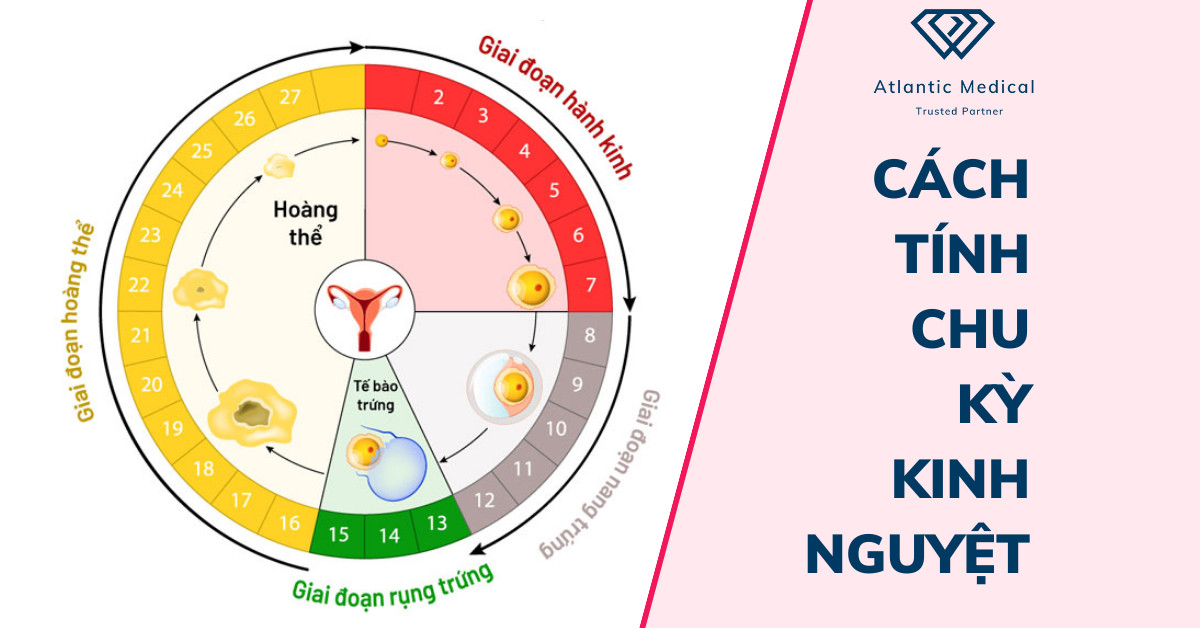
For women, menstruation is a normal manifestation when they are in their reproductive years. Understanding the changes in the body during each phase of the menstrual cycle will help women detect abnormal symptoms as well as calculate a favorable time for plans such as pregnancy, contraception... However, , in reality not many women really understand this issue and in this article, Atlantic Medical will find out with you!
The menstrual cycle is a cyclical bleeding phenomenon in the uterine lining, with Vietnamese women usually having a menstrual cycle length of 28 - 30 days. The first menstrual cycle occurs when women enter puberty between the ages of 10 and 15 and continues for about 40 years until menopause.
A menstrual cycle will consist of two phases: the follicular phase, the luteal phase and the ovulation process in between the two phases. During each stage, the uterine lining will undergo changes in structure and function, and menstruation is the result of these two stages of change.
About the last 2 days of the previous menstrual cycle, the two female sex hormones estrogen and progesterone suddenly decrease in concentration. The uterine lining degenerates and necroses, peeling off from the uterus and causing bleeding. The follicular phase lasts from the first day of menstruation until ovulation.
During this period, two pituitary hormones, FSH and LH, gradually increase, leading to a gradual increase in the concentration of estrogen secreted. The ovary has 6 - 12 primitive follicles that develop, and after 7-8 days of development, one follicle begins to develop rapidly into an egg, the remaining follicles gradually degenerate.
About 2 days before ovulation, LH concentration suddenly increases 6-10 times and reaches the highest level about 16 hours before ovulation, FSH concentration also increases about 2-3 times. Estrogen concentrations begin to decrease 1 day before ovulation, while progesterone concentrations begin to gradually increase under the stimulation of LH hormone.
After menstruation, the uterine lining remains only a thin layer, but under the influence of estrogen, uterine lining cells proliferate, causing the lining to thicken and blood vessels to develop. This process facilitates fertilization and occurs in the second half of the follicular phase.
Although not considered a separate phase, ovulation is an important process for women, occurring in between the two phases of the menstrual cycle. Ovulation occurs within about 12-24 hours, this is the time when fertilization can take place.
The luteal phase lasts from the day of ovulation until the end of the menstrual cycle.
After ovulation, the two hormones FSH and LH are still secreted in decreasing concentrations, stimulating the ruptured follicle to transform into the corpus luteum. Luteal cells under the stimulation of LH secrete a large amount of progesterone, estrogen is also secreted during this period. If pregnancy occurs, progesterone continues to maintain the uterine lining. On the contrary, if pregnancy does not occur, progesterone levels will decrease and a new menstrual cycle will begin.
During the luteal phase, estrogen continues to proliferate and thicken the uterine lining, but the effect is much weaker than progesterone. Blood vessels develop to supply blood to the uterine lining. The purpose of this transformation is to create a uterine lining filled with nutrients for the fertilized egg. If the egg is not fertilized, the uterine lining degenerates and falls off at the end of the luteal phase.
Menstrual cycles can be of different lengths for each person, depending on their constitution and age. For optimal results, women should track their periods for more than 4 months.
For a woman to get pregnant, sperm needs to move through the vagina, enter the uterus and fertilize the egg. According to many experts, after ovulation, eggs can live for up to 1 more day and sperm can live for up to 5 days inside a woman's body, so you should have sex 1 day before, during and after ovulation. However, the day of ovulation can also be different for each woman, so it is possible to extend the time period for conception from the 10th to the 20th day of the menstrual cycle. If your menstrual cycle is irregular each month, you should consult a specialist for the most accurate advice.

After day 20 of the cycle, the follicle ruptures and transforms into a corpus luteum, and the uterine lining degenerates and falls off, preparing for the menstrual phase of the next cycle. During this time, many couples often choose to have sex without using safety measures because the conception rate is very low.
Menstrual cycle length is different for each woman, so there is still a chance of unwanted pregnancy. In addition, ovulation time can be affected by other factors such as emotions, activities, side effects of medications... Therefore, to be able to perform the best contraception as well as prevent sexual diseases , couples should still use safety measures such as using condoms.
If you have any questions, please pick up the phone and contact us immediately Hotline 0936.236.283 or leave a question here to be the pharmacist's Atlantic Medical answers and advice
Wishing you and your family good health and quality life!

Business Registration Certificate No. 0109881571 issued by Hanoi Department of Planning and Investment on January 10, 2022
© 2023 Copyright by Atlantic Medical All rights reserved.